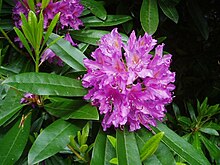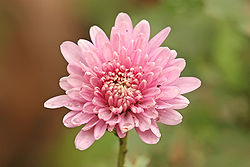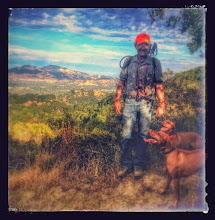"Plants that you are used to seeing in public parks, your neighborhood and perhaps even in your own backyard can lead to devastating effects. In what follows, I will review five of these dangerous plants so that you will be able to identify and avoid them when you’re with your dog. First up are four plants commonly used in landscaping that are actually toxic to canines …
Azalea – Rhododendron Species

A typical choice for landscapers due to its hardiness and lovely flowers, these unassuming ornamentals contain a toxin which can be lethal, even in small amounts. Both the plant’s leaves and nectar are known to be harmful if eaten or chewed by your dog, and can cause drooling (often a symptom of nausea), vomiting, weakness and collapse. If greater amounts of its toxins are ingested, it can lead to severe poisoning, possible coma and even death.
Oleander

Widely recognized as one of the most poisonous plants in the world, even minute quantities of Oleander can trigger a fatal response. Unlike the Azalea, every part of the Oleander is toxic, from flowers to roots. If dogs should chew on any part of this plant, they could suffer varying degrees of illness, including upset stomach, abnormal heart functioning and possibly even death. Beware of the sap, which can irritate the skin and eyes, as well as the leaves, which retain their toxicity even when dried out.
Sago Palm

Most commonly used in planned landscapes where climates tend to be hot and dry, Sago Palms are nevertheless popular all over the U.S. While the whole plant contains harmful chemicals, it’s the seeds that contain the highest levels of toxins. Estimates currently put the percentage of animals that die after eating the seeds of the plant as high as three out of four. The incidence of Sago Palm poisoning in dogs and cats has risen 200% in the past few years, although dogs seem to enjoy the flavor of the plant and the seeds more than cats. Ingestion of Sago Palm can cause vomiting, diarrhea, liver failure and seizures.
Chrysanthemum

Chrysanthemums are popular ornamentals blooming late in the summer and early in the fall. While beautiful, their flowers contain a natural insecticide. If a canine chews on the Chrysanthemum blooms, the insecticide can cause excessive drooling, vomiting and diarrhea. If your furry one is exposed to any of these toxic plants, please contact your veterinarian immediately. As is often the case in toxins and poisons, the sooner your pet receives treatment, the less likely they are to experience dramatic, and sometimes fatal, reactions.
And now, I will review a common weed that can cause a great deal of grief for your pet canine …
Foxtails

Weeds that resemble the tail of a fox, Foxtails are considered a widespread nuisance in most states, especially west of the Mississippi. Prevalent from late spring to early fall, they become more dangerous in late summer when their seeds dry. When the seeds are released from their pods, they are covered in barbs like little fish hooks, making them potentially very dangerous to your dog. If she merely brushes up against the Foxtail plant, the seeds can become snagged in her coat. Worse, the seeds can pierce the skin, or even be inhaled!
As a result, Foxtail seeds can become lodged between a dog’s toes, in their ears or armpits; they can be inhaled or swallowed and latch onto the interior walls of the nose or throat; or, they can stick to the eyes. Obviously, all of these circumstances can be very painful. Perhaps most frightening, the seeds are so small that they can be difficult to locate, and, if embedded in the skin, have been known to migrate to other areas of the body, resulting in severe infections.
If the Foxtail seed becomes infected under the skin, it may result in a visible, inflamed and painful lump. Commonly these lumps are between the toes, and are painful enough that your dog will repeatedly lick or chew the raised area. If a seed becomes lodged in your dog’s nose, she will likely sneeze, violently and over-and-over, and may even repeatedly paw at her face. If the seed latches to or in her ear, she will likely shake her head side-to-side and/or scratch incessantly at her ear. In the case where a Foxtail becomes stuck in or near the eye, you’ll likely see lots of repeated squinting, tears and redness; you may even see the foxtail poking out!
If you see any evidence of an encounter with a Foxtail, take your dog to the vet immediately. If you notice a red bump in between the toes, soak the paw in a mixture of lukewarm water and Epsom salts. This will help to ease the swelling until you can be seen by your veterinarian. Keep in mind that the longer you wait for treatment, the more difficult it is to treat an embedded Foxtail seed, so time is of the essence.
The best way to prevent Foxtail incidents is with an ounce of prevention. During hikes, keep your dog away from grassy weeds, and check her paws after walks. In addition, you should consider brushing her coat while using your hand to feel for any raised areas, checking inside the ears, in between toes, under armpits and throughout the belly and groin area. If you find a Foxtail in the coat, carefully pull or brush it out. If your dog has thick or long hair, consider getting a ‘Foxtail Clip’, a term applied to trimming away the hair between your dog’s toes. And, if you live in an area where Foxtails are common, remove them from your yard (be sure to exercise caution and carefully bag the weeds).
By using a little common sense and being aware of your surroundings, summer walks can be fun and free from environmental injuries. Then, you can get back to making some wonderful, new, summer memories together with your dog outdoors."
Dr. Jane Bicks, DVM
http://www.f-r-r.com/B1416076367/C314935631/E20100805180043/index.html









No comments:
Post a Comment